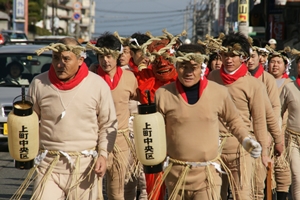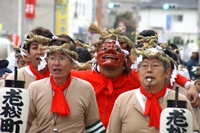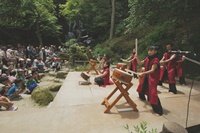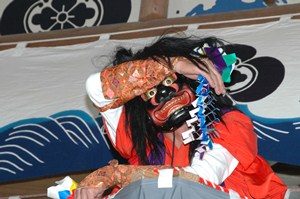Itoshima has been a cultural center since the era of ancient Itokoku, and
the people here continue to
treasure their unique festival traditions so deeply rooted in the land,
such as the kagura dance and
the Yamakasa.
In recent years new events have been added, creating new spots for exchange
and excitement
throughout the city.
|
| “Akamai” Red Rice Appreciation and Exchange |
A visual poem of autumn: the reddish rice paddies of Nijo.
 The red rice of Nijo came to Japan from the continent in ancient times.
Every September, the rice paddies of Nijo Yoshii turn red, delighting the
eyes of passers-by. The red rice of Nijo came to Japan from the continent in ancient times.
Every September, the rice paddies of Nijo Yoshii turn red, delighting the
eyes of passers-by.
Before the harvest each year the people gather to appreciate its beauty
together, enjoying handmade noodles made with the just-harvested red rice.
Towers are erected on the paths between the rice paddies, allowing you
to look down and see the characters and figures created using the living
red and green rice plants.
Nijo red rice grows well under even harsh conditions, and is rich in vitamins
and minerals. Since it requires very little agrochemicals or fertilizer,
it is receiving attention of late as the world becomes increasingly aware
of the deterioration of the natural environment and the rising need for
food safety.
|
| Event site |
Rice paddies in Nijo Yoshii, Itoshima |
| Inquiries |
092-326-6334 (Nijo Branch, Itoshima Tourism Association) |
| Event dates |
Around the 2nd Sunday in September |
| Access |
About 30 minutes on foot from JR Fukuyoshi Station |
|
|
| Oimatsu Shrine Tuina Festival |
A Traditional Spring Ceremony to Scare Away Demons and Bad Luck
 This ceremony is said to have been brought here from China in ancient
times, when an epidemic was sweeping the region. This ceremony is said to have been brought here from China in ancient
times, when an epidemic was sweeping the region.
At about two o’clock in the afternoon, people of all ages dressed as demons
follow their huge leader, who wears a red mask, out of the shrine to terrorize
and desecrate the town. They chant “One ja!
(We are demons!) Oni ja!” as they race through the streets, heading toward
the river about two kilometers distant.
 In the evening the Onisube is held. When the giant demon leader attempts
to return from the river to the Shrine, the town mayor throws beans at
him, driving him into the adjacent hall. Inside the hall, the little demons
torment him with smoke from burning pine branches, driving away the evil. In the evening the Onisube is held. When the giant demon leader attempts
to return from the river to the Shrine, the town mayor throws beans at
him, driving him into the adjacent hall. Inside the hall, the little demons
torment him with smoke from burning pine branches, driving away the evil.
A variety of charms called “uso” are also sold on this day, for home safety,
success in business or school, and a rich harvest, along with a lottery,
bring many people their first good luck of the year.
|
| Event site |
Oimatsu Shrine, 1-4-14 Maebaru Chuo, Itoshima |
| Inquiry |
092-322-2098 (Maebaru Branch, Itoshima Tourism Association) |
| Event date |
January 7 |
| Access |
7 to 10 minutes on foot from JR Chikuzen-Maebaru Station |
|
|
Opening of Shiraito Falls
|
|
A Fun Event Announcing the Opening of the Tourism Season
 Every summer, people come to Shiraito Falls seeking its cool air and water.
The official opening is also an exchange event that prays for summer safety. Every summer, people come to Shiraito Falls seeking its cool air and water.
The official opening is also an exchange event that prays for summer safety.
There is a variety of fun things to see and do, including a stimulating
performance by a local drum group, mocha rice ball toss, somen noodles,
and river trout fishing.
Even in early summer when the humidity begins to bother people, the area
 around the falls is full of negative ions for a fresh feeling. The Shiraito
Hydrangea Society has planted 5500 seedlings here, and some 100,000 beautiful
blooms delight the visitor. around the falls is full of negative ions for a fresh feeling. The Shiraito
Hydrangea Society has planted 5500 seedlings here, and some 100,000 beautiful
blooms delight the visitor.
|
| Event site |
Shiraito, Itoshima |
| Inquiries |
092-323-2114 Shiraito Falls Fureai-no-Sato) |
| Event date |
2nd Saturday in June |
| Access |
30 minutes by bus to Shiraito from JR Chikuzen-Maebaru Station, and a 25-minute
walk |
|
|
| Takasu Kagura Dance |
An ethereal world, reborn across six centuries
 Takasu Kagura Dance, renowned for its history, tradition and stately grace,
is said to have been brought here by the lord of the region in 1467, from
Kyoto. Takasu Kagura Dance, renowned for its history, tradition and stately grace,
is said to have been brought here by the lord of the region in 1467, from
Kyoto.
In the Edo period is was danced by the priests and priestesses of the shrine,
but in the Meiji era the local residents of the Takasu region adopted it.
Today, it is preserved and carried on by the Takasu Kagura Dance Preservation
Society.
It is performed on the grounds of Takasu Shrine twice a year, in the spring
and the fall, as an offering. The night dancing in the fall is especially
beautiful and entrancing as the flames invite you into a world of illusion.
A dance is also presented as an offering by the local children. 
There are twelve parts in total, divided into two types: the dance kagura
where participants sing in time to the music without masks, and the mask
kagura where masked participants present myths of the gods. In 1981, it
was designated as an intangible folk cultural property by Fukuoka prefecture. |
| Event site |
1578 Takasu, Itoshima |
| Inquiry |
092-322-7133 (Takasu Shrine office) |
| Event dates |
Spring: April 26, from 13:00 to nightfall.
Fall: October 26, from 18:00 to 22:00 |
| Access |
- By car: Take Route 202 from Fukuoka and turn left at Iiji intersection,
then about 8 minutes
(signs to parking will be up on performance days)
- By JR train: Take Chikuhi Line to Susenji Station, then the Showa Mini-Bus
for Kawabaru to Takasu (about 8 minutes), and a 5-minute walk
|
|
|
|
|